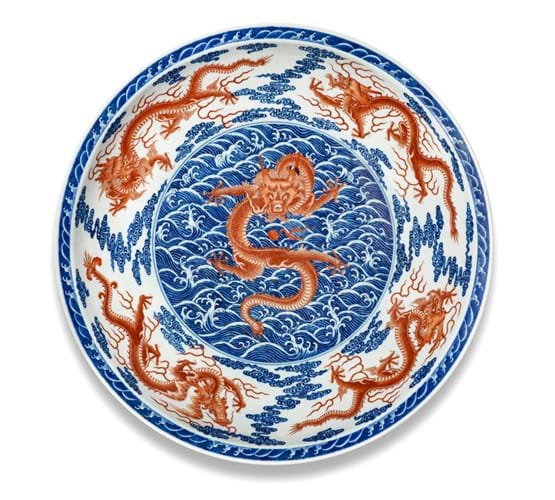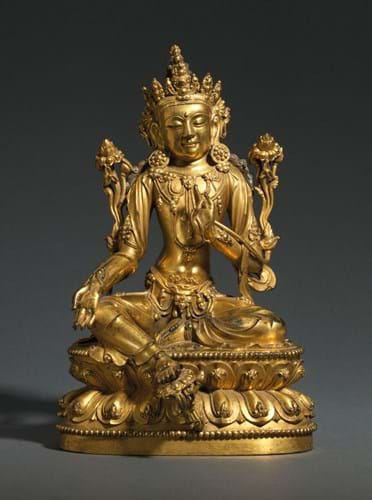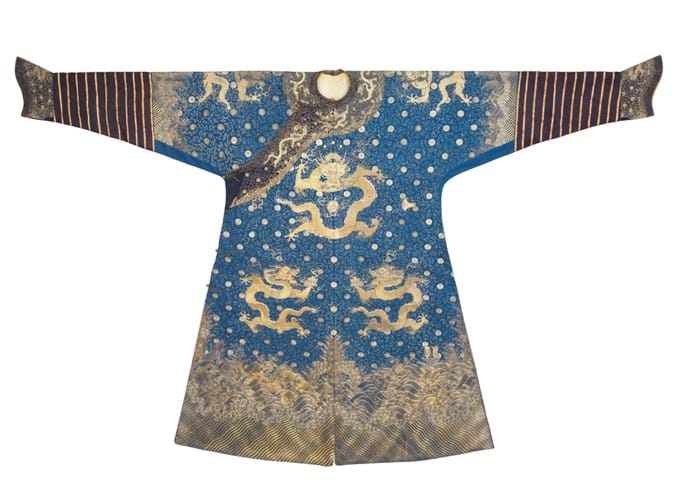Gilt bronze figure of Avalokiteshvara
A 10in (25cm) early 15th century gilt bronze seated figure of Avalokiteshvara was one of several lots to far exceed estimate, selling for at £1.6m (estimate £150,000-200,000) at Christie’s on November 6.
Elegantly outfitted in the sumptuous trappings of an early Indian prince, he dons his definitive identifying attribute - the Buddha Amitabha atop the head. It dates to the reign of Xuande (1426-35) - a time when the imperial court looked favourably upon Buddhism and made a concerted effort to build secular and religious alliances with Tibet. Most such images were made for the court, as indicated by the imperial inscription translating as ‘Bestowed [during the] Xuande era [of the] Great Ming’
This finely-cast figure contains an internal surprise. As indicated by an X-ray taken by Christie’s in an Oxford laboratory, the hollow-case figure retains the dedicatory materials - probably small scrolls, textile fragments and perhaps even seeds of auspicious plants - that were commonly deposited in religious bronzes to enliven the image and grant them efficacy.
Typically such elements have been lost but these are held in place by an original copper plate to the base inscribed with a double vajra.
A renowned British art historian, collector and connoisseur, Soame Jenyns was assistant keeper of Oriental antiquities at the British Museum from 1931-67 and wrote several definitive books on Chinese and Japanese ceramics. Christie’s included 24 pieces in its £8.8m King Street sale and 138 lots sold for £418,000 in a dedicated online catalogue ending on November 8.
Estimated at £20,000-40,000 but sold at £400,000 was a large teapot made in the early years of the reign of the emperor Yongzheng (1723-35). Decorated in famille verte enamels, with the bold use of black and overglaze iron-red, it combines the inscription yu tang chun fu gui ('may your noble house be blessed with riches and honour') together with blooms of magnolia, peony and crab-apple that together create a rebus for this auspicious phrase. To the base is a six-character Yongzheng mark.
The inscription ends with the enigmatic signature Yue Qing (literally ‘moon’ or ‘month’ and ‘minister’ or ‘high official’) followed by a seal mark yun ju (‘cloud dwelling’). Both may relate to a Buddhist monastery. A similar 10½in (27cm) vessel in the collection of the Palace Museum Beijing does not have a reign mark but is thought to date to the late Kangxi period.
The innovative and technically perfect ceramics of the Yongzheng period continue to chime perfectly with so-called Chinese taste.
Moon flask
From another vendor was a large Yongzheng (1725-35) mark and period moon flask or bianhu. Christie’s consultant Rosemary Scott penned a long catalogue note praising its exceptional size at 21in (53cm) high, its distinctive form and the early 15th century Ming style decoration that reflects the emperor’s keen antiquarianism.
The famous director of the imperial kilns, Tang Ying (1682-1756), who first came to Jingdezhen as resident assistant in 1728 and stayed until well into the Qianlong reign, was especially celebrated for his success in imitating Yongle and Xuande wares. A passage in the 1795 history Jingdezhen Taolu by Lan Pu noted that: ‘his close copies of famous wares of the past were without exception worthy partners [of the originals]’.
Consigned from ‘a distinguished European private collection’ with an estimate of £1.2m-1.5m, the vendor’s grandfather acquired it in Asia between 1920-43. It sold at the lower end of expectations at £1.2m.
Corner leg table
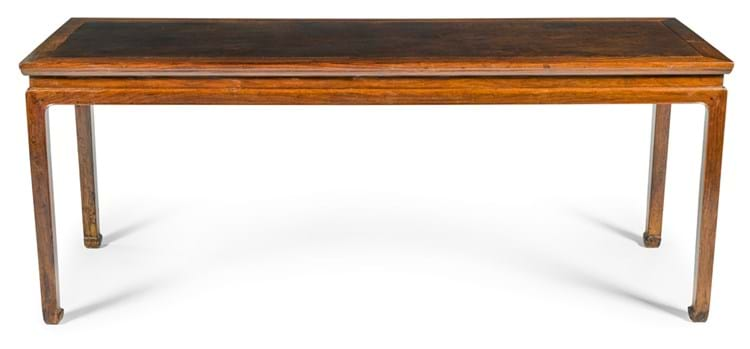
Leading Sotheby’s sale of Important Chinese Art the following day was a fine huanghuali corner leg table with panelled nanmu rectangular top. Dated to the 17th or 18th century, it was much admired for its minimalist form with square section legs culminating at horse-hoof feet. Long tables such as this measuring 6ft 8in (2.04m) across are known as tiaozhuo and were used in the scholar’s studio, as its length and absence of stretchers would have made it suitable for the creation and admiration of scroll paintings. The result, however, was unexpected. Purchased from Albert Chan, Chan Shing Kee, in 1982 and offered a ‘the property of a gentleman,’ it was estimated at £60,000-80,000 but sold at £2.4m. The winning bid, the latest in a series of seven-figure sums for the best Chinese furniture, was the highest of the week.
Spinach-green jades
Sold more in line with expectations were two Qianlong (1735-95) period spinach-green jades. Once in the collection of Robert Napier, First Baron Napier of Magdala (1810-90), they were among the 3080 works exhibited at The Royal Academy’s 1935 International Exhibition of Chinese Art. Jades of this quality, size and colour only became possible during 1760s after the Qing army exerted control over the mines and rivers in the Khotan region. Although collecting taste has moved to lighter coloured sandstone carvings, they were much admired by the Qianlong Emperor who, unlike many of today’s collectors, often chose raw jade with imperfections and blemishes because he believed they better represented the colours of nature.

A washer or marriage bowl carved with six beast-head handles, each with a freely moving ring, measured a huge 20in (50cm) across. According to palace documents of the period, jade washers such as this typically came with two, four, or six rings - the latter the most challenging to carve in an era when jade was cut by hand on an iron mill. French author and jade collector Stanley Charles Nott references this specific piece in his 1936 book Chinese Jade Throughout the Ages. It carried an estimate of £600,000-800,000 and sold at £600,000.
From the same source was a 7in (17cm) imperial spinach jade cylindrical brush pot or bitong meticulously carved in various levels of relief with a gathering scene of five sages in a scenic mountainous landscape. The subject is the Elders of Juyang: five ministers of the Northern Song court who, after retiring from office, lived reclusively in Juyang where they would meet to compose poetry. Both the peaches they hold and the choice of three large trees of auspicious significance symbolise longevity. Estimated at £300,000-500,000, it sold at £580,000.
A Kangxi-Qianlong spinach jade brush pot of the same size carved with the same subject sold for Euro751,500 at Sotheby’s Paris in June 2017. It was part of a collection of Qing jades formed in the 1960s and unseen on the market since.
The sale totalled a premium-inclusive £9.2m. However, with 85 of the 145 lots finding buyers, the overall response was selective.
Qing magnificence
Bonhams' mixed-owner sale titled Fine Chinese Art on November 8 was also dominated by Qing magnificence. Sold at £440,000 was a large Imperial Qianlong mark and period underglaze-blue and iron-red enamel 'nine dragon' dish. This particular design, inspired by early Ming ceramics, was championed in the Yongzheng period, but this example, measuring close to 19in (48cm) across, is one of only a handful of dishes of this type from the Qianlong period. Records from the imperial household note the presentation of a dish of this description (a 'large Xuande-kiln dish with red dragons amongst blue clouds and waves') to the emperor on the 25th day in the sixth month of the third year of the Qianlong period, corresponding to 1738.
This dish was purchased by the British businessman and Hong Kong politician Sir David Newbigging in China in 1960, and brought to the UK in 1984.
Imperial jifu
An imperial jifu from the Qianlong period came for sale from the family of Brigadier-General Offley Bohun Stovin Fairless Shore (1863-1922) who had acquired it during a visit to Beijing from March 5-19, 1912. His wife’s letter of September 24, 1913, describes them attending a fancy dress ball in which "Offley wore the beautiful Chinese coat of blue and gold and silver that we bought in Peking”.
Midnight blue-ground robes - here embroidered with nine I five-clawed dragons and the Twelve Symbols of Imperial authority - were only worn by the emperor twice a year during the performance of ceremonies aimed at invoking rain and good harvest at the Temple of Heaven. All imperial paraphernalia used at this location shared the same colour.
A similar robe was sold at Christie's New York in March 2004 for a premium-inclusive $192,300. This example took £380,000 (estimate £100,000-150,000).
Wood seated figures
At £420,000 (estimate £120,000-150,000), a pair of carved wood seated figures of Avalokiteshvara (Guanyin) from the Southern Song period was the top lot of Bonhams’ 35-lot sale titled The Ollivier Collection of Early Chinese Art: A Journey Through Time. The French businessman and philanthropist, Jean-Yves Ollivier, began his collecting odyssey after visiting the National Palace Museum in Taipei in the late 1960s. These finely carved 17in (44cm) high figures, that would have stood either side of an altar, were last sold in 1995 at Christie’s London as part of a collection from Rome.
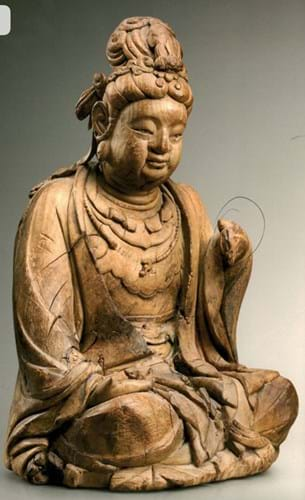
Olliver had bought a large Tang sancai-glazed statue of a braying camel standing 2ft 8in (82cm) high from a dealer in Hong Kong in November 1991. The Tang capital, Chang'an – one of the largest and most cosmopolitan cities in the world in the 9th century – became vastly wealthy thanks to its key position on the Silk Road. Caravans of Bactrian camels, imported from Turkestan and Mongolia, were essential for conducting trade with the oasis cities of Central Asia, such as Samarkand, and those in Syria and Persia. The species was highly regarded by the Tang emperors who established dedicated offices to oversee the imperial camel herds. It sold at the lower end of a £300,000-400,000 estimate, helping Bonhams to a total close to £6m.
Both Bonhams and Sotheby’s also held stand-alone sales of Japanese art. More UK Asian art sales, timed to coincide with Asian Art in London, take place this week including those at Roseberys London and Chiswick Auctions (both November 12) and Woolley & Wallis (November 13-14).


